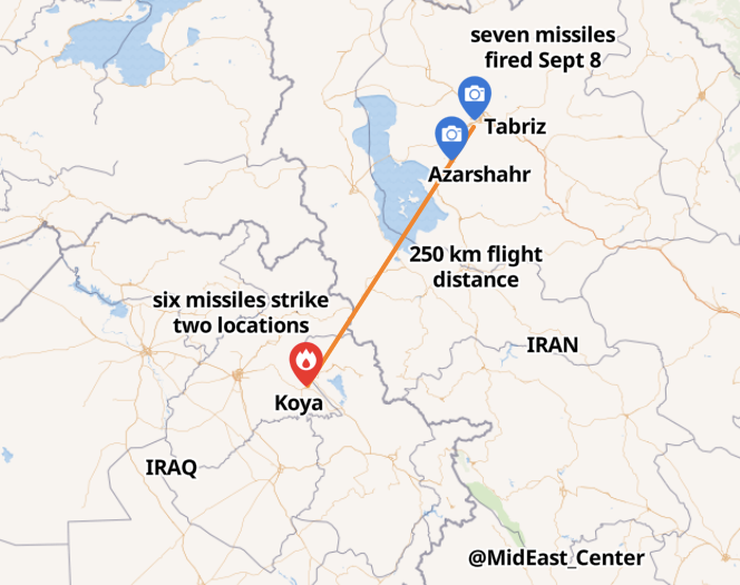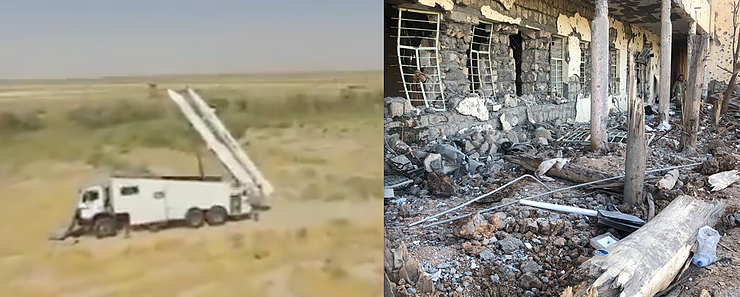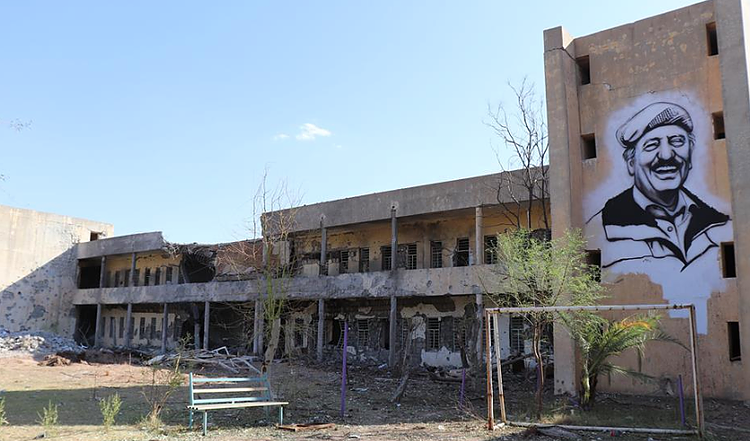The IRGC missile launcher and the destruction at Koya (screenshot, left; Zach Huff, right)
Middle East Center for Reporting and Analysis
The Islamic Revolutionary Guard Corps (IRGC) of Iran carried out a missile attack on Kurdish opposition groups in northern Iraq’s Koya on September 8. The IRGC later released a statement and footage of the missiles being fired as well as a drone monitoring the KDP-I headquarters that was struck.
The footage as well as other information reveals the accuracy that the Fateh 110 missile that was used is capable of. Not all the details are fully known, but an investigation, including a visit to the site of the missile attack by Zach Huff, reveals important details about the IRGC’s actions.
The IRGC says that it carried out the attack with its “IRGC Aerospace Missile Unit, with the participation of a UAV unit On Saturday, in a successful operation, the IRGC targeted a deployment site and a meeting of one of the criminal and criminal gangs and associated terrorists.” It linked the missile strike to “intelligence and readiness of the IRGC’s forces, including those in the past few weeks in the Marivan and Kamyaran border areas, suffered deadly strikes, punishing and dealing with terrorists.”
A New Administration In Northeast Syria?
Iran has access to several missile that it could have used in the attack. These include the Fateh 110, the Fajr 5, the Zelzal and the Zulfiqar. The multiple rocket launch system Fajr 5, a two-stage, nine meter long, artillery rocket has been shown off by Iran but was not suitable because most of its versions are unguided. In February 2017, Iran revealed a guided version of the Fajr-5. The Zelzal family of rockets reach between 150 to 250 km. It was turned into a guided rocket and its third generation included a GPS.
The Fateh, with a range from 200-300km was an ideal choice. Developed from a version of the Zelzal it is highly precise. It is also a missile Iran has been working to improve. For instance Anthony Cordesman writes in 2014: “the fourth generation of the Fateh 110 missile, with a range of more than 300 kilometers, was successfully tested by the Aerospace Organization of the Defense Ministry.” Iran bragged that “the [the missile can target] enemy deployment areas, command centers, missile sites, ammunition depots, radar and other targets with 100% precision.” Cordesman noted that it was one of the most notable elements in Iran’s missile progra. The “Fateh-110C single stage, solid propellant rocket with a 250-275 km range; Fateh-110 SRBMs with a 280-300 km range, and variants in development with a range greater than 500 kms.”
But the Fateh program has many unknown features. “Little is known about the operational accuracy and deployed numbers of this system. The system is believed to have entered full-scale production in 2004,” Cordesman continues, “Iran did announce that it was developing two new versions of the Fateh-110 on February 10, 2014.” This Guided ballistic missile, “Iran claims that it has developed a modification of the Fateh-110 called the Khalij Fars,..It is also reported to have a CEP in the hundreds of meters, although the CEP accuracy of the guidance platform is not a reliable or meaningful indication of actual missile performance.”
The strike on Koya on September 8 began in the morning around 10:45am. Missiles struck at least two locations, including a training facility of the PDKI and a headquarters of KDP-I. The latter is a large square building and the missiles struck one room in the building where a meeting was taking place. In such a large complex, the ability to strike outside and above that room points to either amazing luck or great accuracy and intelligence. Drones monitored the damage after. Commentators have since debated if the rockets used were the third generation Fateh 3, others have suggested the second generation. Some have labelled it a Fateh 110 B. The older generations of the Fateh 110 were only accurate up to several hundred meters, while the more recent ones were supposed to be accurate up to a much smaller radius.
Video showed the launch of the missiles from near Tabriz. One was viewed veering off course. Videos near Azarshahr in Iran showed the missiles flying over. The video released by the IRGC as well as video shot by civilians near Tabriz showed the smoke trails of the missiles and the multiple launchings.
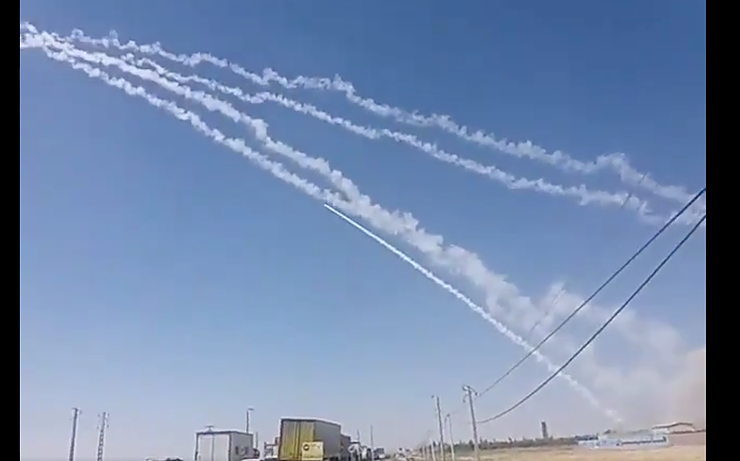
Screen shot of the launch near Tabriz
Video also showed the impacts of the missiles in Koya. Shot from the eastern side of Koya, perhaps near the university, the video shows the strikes west of Koya at the large building used by the KDP-I and at facilities used by PDKI.
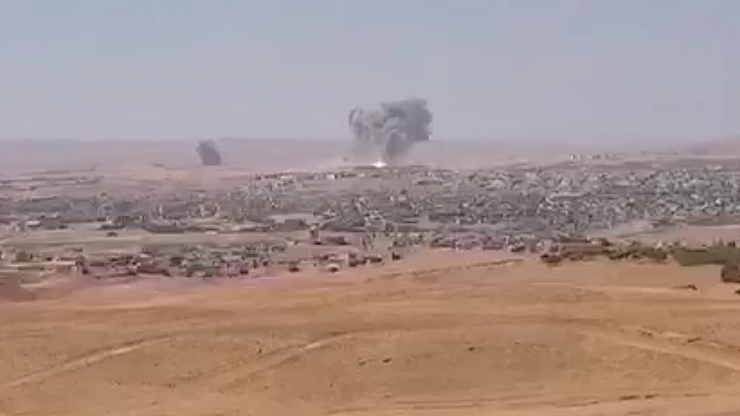
Video from Koya showed several impacts (screenshot)
The video clearly shows that several of the missiles did impact their intended targets.
The details still leave some questions unanswered. The level of destruction of the building was photographed by Zach Huff. The type of launcher was shown in the IRGC video. But not all the details are known about this missile. Iran tested a version of the Fateh 110 in August. It had also tested a different version in March 2017.
A Failing Iran Remains A Dangerous Iran
However an Iranian media source wrote on social media that this is a second generation Fateh 110-b that was tested 10 years ago.
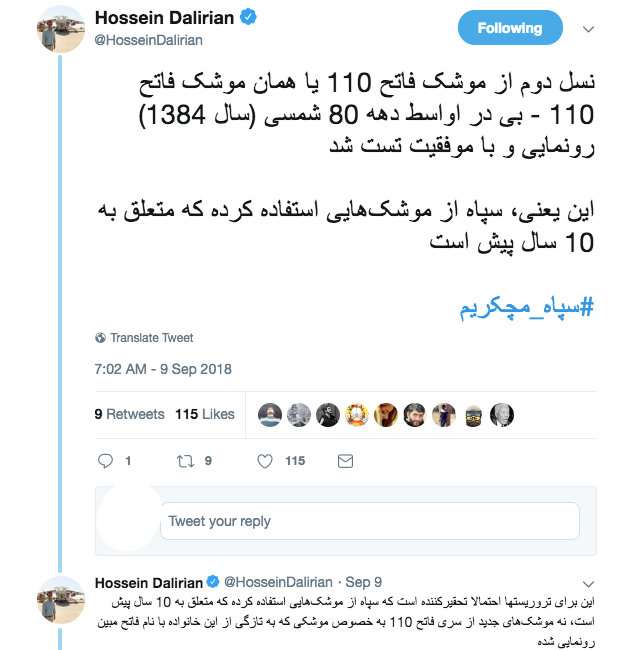
A series of tweets about the warhead and missile “information related to the missile range FATEH110-B: about 300 km. fuel: solid war head weight.” (screenshot)
The impact sites
Zach Huff visited the impact sites of the missiles. The KDP-I building was struck twice, once in an outside area, and once above the room where the meeting was taking place. Trees were cut down by the blast.
In addition a training facility of the PDKI was struck and fields are shown burned nearby. The craters of the impact were photographed, as well as a funeral for the fallen.
The full details of the Koya attack are still emerging. However Iran’s IRGC seems pleased with its ability to target opposition groups. It also wants to highlight the accuracy of its missiles and ability to blend intelligence gathering, drones and missiles into one working system.


